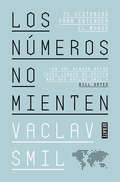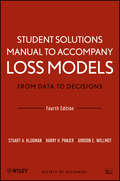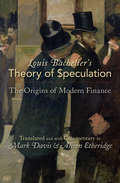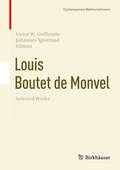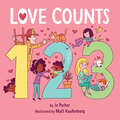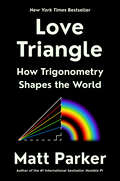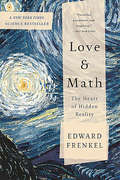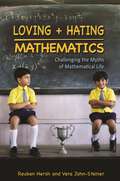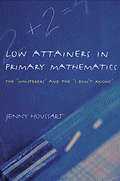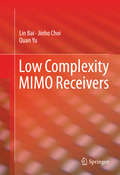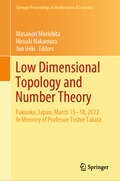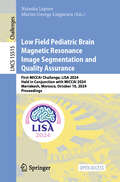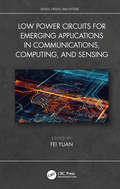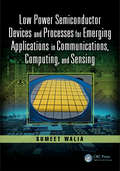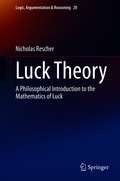- Table View
- List View
Los animales no se dormian / The Animals Would Not Sleep (Storytelling Math)
by Sara Levine¡Celebremos la diversidad, las matemáticas y el poder del cuento! Celebrate diversity, math, and the power of storytelling!¡Ahora en edición bilingüe inglés-español! Es hora de que Marco y sus animales de peluche se vayan a dormir, pero los animales tienen otro plan. Cuando Marco trata de guardarlos, empiezan a volar, nadar y reptar de las canastas donde los tiene. ¿Podrá Marco clasificar a sus animales para que todos estén contentos? Una exploración divertida sobre lo que es clasificar con personajes latinxs y una nota sobre clasificación científica. Los libros de la serie Cuentos matemáticos celebran las aventuras diarias de niños que usan las matemáticas mientras juegan, construyen y descubren el mundo que los rodea. Historias divertidas y actividades prácticas facilitan que tanto los niños como los adultos exploren juntos las matemáticas de la vida diaria. Fue desarrollada junto a expertos en el currículum STEM, pertenecientes a TERC Inc., organización sin fines de lucro, bajo una subvención otorgada por Heising-Simons Foundation. Now in a Spanish bilingual edition! It's bedtime for Marco and his stuffed animals, but the animals have other ideas. When Marco tries to put them away, they fly, swim, and slither right out of their bins! Can Marco sort the animals so everyone is happy? A playful exploration of sorting and classifying, featuring Latinx characters and a note about scientific classification.Storytelling Math celebrates children using math in their daily adventures as they play, build, and discover the world around them. Joyful stories and hands-on activities make it easy for kids and their grown-ups to explore everyday math together. Developed in collaboration with math experts at STEM education non-profit TERC, under a grant from the Heising-Simons Foundation.
Los números no mienten: 71 historias para entender el mundo
by Vaclav SmilUn maestro de los datos y las estadísticas ofrece una visión del mundo tan sorprendente como iluminadora. ¿Es peligroso volar? ¿Qué es peor para el medioambiente, un coche o un móvil? ¿Cuánto pesan todas las vacas del mundo juntos y por qué ese dato importa? ¿Se puede medir la felicidad? La misión de Vaclav Smil es convencernos de que los hechos importan. Científico medioambiental, analista de políticas públicas y autor tremendamente prolífico, es el referente de Bill Gates cuando se trata de entender el mundo. En Los números no mienten, nos embarcamos con Smil en una fascinante expedición en busca de datos que desafían nuestras preconcepciones, al tiempo que nos invita a ver con nuevos ojos el impacto de las transformaciones del mundo moderno sobre la sociedad y el medioambiente. Basado en divertidos ejemplos, estadísticas y gráficas asombrosas, este libro es la combinación perfecta de ingenio, historia y ciencia quecambiará la manera en que vemos el mundo. Es posible que los números no mientan, pero ¿qué verdad transmiten? La crítica ha dicho...«El título de Smil lo dice todo: para entender el mundo hay que examinar las líneas de tendencia, no los titulares. Un retrato fascinante, convincente y sobre todo realista del mundo actual y de hacía dónde nos dirigimos.»Steven Pinker «La palabra "erudito" se inventó para describir a gente como él.»Bill Gates «Uno de los pensadores más importantes del mundo sobre la historia del desarrollo y un maestro del análisis estadístico.»The Guardian
Loss Models
by Harry H. Panjer Stuart A. Klugman Gordon E. WillmotPraise for the Third Edition"This book provides in-depth coverage of modelling techniques used throughout many branches of actuarial science. . . . The exceptional high standard of this book has made it a pleasure to read." --Annals of Actuarial ScienceNewly organized to focus exclusively on material tested in the Society of Actuaries' Exam C and the Casualty Actuarial Society's Exam 4, Loss Models: From Data to Decisions, Fourth Edition continues to supply actuaries with a practical approach to the key concepts and techniques needed on the job. With updated material and extensive examples, the book successfully provides the essential methods for using available data to construct models for the frequency and severity of future adverse outcomes.The book continues to equip readers with the tools needed for the construction and analysis of mathematical models that describe the process by which funds flow into and out of an insurance system. Focusing on the loss process, the authors explore key quantitative techniques including random variables, basic distributional quantities, and the recursive method, and discuss techniques for classifying and creating distributions. Parametric, non-parametric, and Bayesian estimation methods are thoroughly covered along with advice for choosing an appropriate model.New features of this Fourth Edition include:Expanded discussion of working with large data sets, now including more practical elements of constructing decrement tablesAdded coverage of methods for simulating several special situationsAn updated presentation of Bayesian estimation, outlining conjugate prior distributions and the linear exponential family as well as related computational issuesThroughout the book, numerous examples showcase the real-world applications of the presented concepts, with an emphasis on calculations and spreadsheet implementation. A wealth of new exercises taken from previous Exam C/4 exams allows readers to test their comprehension of the material, and a related FTP site features the book's data sets.Loss Models, Fourth Edition is an indispensable resource for students and aspiring actuaries who are preparing to take the SOA and CAS examinations. The book is also a valuable reference for professional actuaries, actuarial students, and anyone who works with loss and risk models.To explore our additional offerings in actuarial exam preparation visit www.wiley.com/go/c4actuarial .
Loss Models: Further Topics (Wiley Series in Probability and Statistics #977)
by Harry H. Panjer Stuart A. Klugman Gordon E. WillmotAn essential resource for constructing and analyzing advanced actuarial models Loss Models: Further Topics presents extended coverage of modeling through the use of tools related to risk theory, loss distributions, and survival models. The book uses these methods to construct and evaluate actuarial models in the fields of insurance and business. Providing an advanced study of actuarial methods, the book features extended discussions of risk modeling and risk measures, including Tail-Value-at-Risk. Loss Models: Further Topics contains additional material to accompany the Fourth Edition of Loss Models: From Data to Decisions, such as: Extreme value distributions Coxian and related distributions Mixed Erlang distributions Computational and analytical methods for aggregate claim models Counting processes Compound distributions with time-dependent claim amounts Copula models Continuous time ruin models Interpolation and smoothing The book is an essential reference for practicing actuaries and actuarial researchers who want to go beyond the material required for actuarial qualification. Loss Models: Further Topics is also an excellent resource for graduate students in the actuarial field.
Lost Childhood: Unmasking the Lives of Street Children in Metropolitan India
by Kapil Dev Dipendra Nath Das Sangeetha EstherLost Childhood explores the everyday lives of street children in India. It presents insights on their life on the streets to provide a comprehensive understanding of why they are driven to extreme means of livelihoods. This volume, · Inquiries into the histories of street children, and discusses their socio-economic and socio-demographic characteristics to provide a sense of their living conditions; · Sheds light on the social injustice experienced by these children, their health and hygiene, and also looks at the insecurities faced by the children in their interactions with the society; · Uses detailed field research data to highlight issues that affect the lives of street children such as education, gender discrimination, and their social networks; · Suggests a way forward that would not only benefit street children but will also be of use to the community in understanding their lives, problems, and help explore this issue in further detail. The book will be useful to scholars and researchers of human geography, development studies, child development, urban poverty, and social justice. It will also be of interest to policymakers, social workers, and field workers who work with street children.
Lost in Math: How Beauty Leads Physics Astray
by Sabine HossenfelderA contrarian argues that modern physicists' obsession with beauty has given us wonderful math but bad science Whether pondering black holes or predicting discoveries at CERN, physicists believe the best theories are beautiful, natural, and elegant, and this standard separates popular theories from disposable ones. This is why, Sabine Hossenfelder argues, we have not seen a major breakthrough in the foundations of physics for more than four decades. The belief in beauty has become so dogmatic that it now conflicts with scientific objectivity: observation has been unable to confirm mindboggling theories, like supersymmetry or grand unification, invented by physicists based on aesthetic criteria. Worse, these "too good to not be true" theories are actually untestable and they have left the field in a cul-de-sac. To escape, physicists must rethink their methods. Only by embracing reality as it is can science discover the truth.
Louis Bachelier's Theory of Speculation: The Origins of Modern Finance
by Louis BachelierMarch 29, 1900, is considered by many to be the day mathematical finance was born. On that day a French doctoral student, Louis Bachelier, successfully defended his thesis Théorie de la Spéculation at the Sorbonne. The jury, while noting that the topic was "far away from those usually considered by our candidates," appreciated its high degree of originality. This book provides a new translation, with commentary and background, of Bachelier's seminal work. Bachelier's thesis is a remarkable document on two counts. In mathematical terms Bachelier's achievement was to introduce many of the concepts of what is now known as stochastic analysis. His purpose, however, was to give a theory for the valuation of financial options. He came up with a formula that is both correct on its own terms and surprisingly close to the Nobel Prize-winning solution to the option pricing problem by Fischer Black, Myron Scholes, and Robert Merton in 1973, the first decisive advance since 1900. Aside from providing an accurate and accessible translation, this book traces the twin-track intellectual history of stochastic analysis and financial economics, starting with Bachelier in 1900 and ending in the 1980s when the theory of option pricing was substantially complete. The story is a curious one. The economic side of Bachelier's work was ignored until its rediscovery by financial economists more than fifty years later. The results were spectacular: within twenty-five years the whole theory was worked out, and a multibillion-dollar global industry of option trading had emerged.
Louis Boutet de Monvel, Selected Works
by Victor W. Guillemin Johannes SjöstrandThis book features a selection of articles by Louis Boutet de Monvel and presents his contributions to the theory of partial differential equations and analysis. The works selected here reveal his central role in the development of his field, including three cornerstones: firstly, analytic pseudodifferential operators, which have become a fundamental aspect of analytic microlocal analysis, and secondly the Boutet de Monvel calculus for boundary problems for elliptic partial differential operators, which is still an important tool also in index theory. Thirdly, Boutet de Monvel was one of the first people to recognize the importance of the existence of generalized functions, whose singularities are concentrated on a single ray in phase space, which led him to make essential contributions to hypoelliptic operators and to a very successful and influential calculus of Toeplitz operators with applications to spectral andindex theory. Other topics treated here include microlocal analysis, star products and deformation quantization as well as problems in several complex variables, index theory and geometric quantization. This book will appeal to both experts in the field and students who are new to this subject.
Love Counts
by Jo ParkerCount down from 10 and discover the many ways children can spread love in the world!Whether it's sharing cookies with neighbors, sending a letter to a loved one, or giving thanks to the people who keep the world going 'round, this is the perfect book to read aloud with children to teach them that love counts.With playful rhymes and thoughtful illustrations, young readers will learn 10 simple ways to share love with family, neighbors, animals, teachers...and even themselves.
Love Triangle: How Trigonometry Shapes the World
by Matt ParkerAN INSTANT NEW YORK TIMES BESTSELLER!An ode to triangles, the shape that makes our lives possible Trigonometry is perhaps the most essential concept humans have ever devised. The simple yet versatile triangle allows us to record music, map the world, launch rockets into space, and be slightly less bad at pool. Triangles underpin our day-to-day lives and civilization as we know it. In Love Triangle, Matt Parker argues we should all show a lot more love for triangles, along with all the useful trigonometry and geometry they enable. To prove his point, he uses triangles to create his own digital avatar, survive a harrowing motorcycle ride, cut a sandwich, fall in love, measure tall buildings in a few awkward bounds, and make some unusual art. Along the way, he tells extraordinary and entertaining stories of the mathematicians, engineers, and philosophers—starting with Pythagoras—who dared to take triangles seriously. This is the guide you should have had in high school—a lively and definitive answer to &“Why do I need to learn about trigonometry?&” Parker reveals triangles as the hidden pattern beneath the surface of the contemporary world. Like love, triangles actually are all around. And in the air. And they&’re all you need.
Love and Math: The Heart of Hidden Reality
by Edward FrenkelWhat if you had to take an art class in which you were only taught how to paint a fence? What if you were never shown the paintings of van Gogh and Picasso, weren’t even told they existed? Alas, this is how math is taught, and so for most of us it becomes the intellectual equivalent of watching paint dry. In Love and Math, renowned mathematician Edward Frenkel reveals a side of math we’ve never seen, suffused with all the beauty and elegance of a work of art. In this heartfelt and passionate book, Frenkel shows that mathematics, far from occupying a specialist niche, goes to the heart of all matter, uniting us across cultures, time, and space. Love and Math tells two intertwined stories: of the wonders of mathematics and of one young man’s journey learning and living it. Having braved a discriminatory educational system to become one of the twenty-first century’s leading mathematicians, Frenkel now works on one of the biggest ideas to come out of math in the last 50 years: the Langlands Program. Considered by many to be a Grand Unified Theory of mathematics, the Langlands Program enables researchers to translate findings from one field to another so that they can solve problems, such as Fermat’s last theorem, that had seemed intractable before. At its core, Love and Math is a story about accessing a new way of thinking, which can enrich our lives and empower us to better understand the world and our place in it. It is an invitation to discover the magic hidden universe of mathematics.
Loving and Hating Mathematics: Challenging the Myths of Mathematical Life
by Vera John-Steiner Reuben HershAn exploration of the hidden human, emotional, and social dimensions of mathematicsMathematics is often thought of as the coldest expression of pure reason. But few subjects provoke hotter emotions—and inspire more love and hatred—than mathematics. And although math is frequently idealized as floating above the messiness of human life, its story is nothing if not human; often, it is all too human. Loving and Hating Mathematics is about the hidden human, emotional, and social forces that shape mathematics and affect the experiences of students and mathematicians. Written in a lively, accessible style, and filled with gripping stories and anecdotes, Loving and Hating Mathematics brings home the intense pleasures and pains of mathematical life.These stories challenge many myths, including the notions that mathematics is a solitary pursuit and a "young man's game," the belief that mathematicians are emotionally different from other people, and even the idea that to be a great mathematician it helps to be a little bit crazy. Reuben Hersh and Vera John-Steiner tell stories of lives in math from their very beginnings through old age, including accounts of teaching and mentoring, friendships and rivalries, love affairs and marriages, and the experiences of women and minorities in a field that has traditionally been unfriendly to both. Included here are also stories of people for whom mathematics has been an immense solace during times of crisis, war, and even imprisonment—as well as of those rare individuals driven to insanity and even murder by an obsession with math.This is a book for anyone who wants to understand why the most rational of human endeavors is at the same time one of the most emotional.
Low Attainers in Primary Mathematics: The Whisperers and the Maths Fairy
by Jenny HoussartIn this fascinating book, Jenny Houssart draws on close observations with children in lower mathematics sets in primary schools to investigate why some children opt out of mathematics at an early age. After introducing us to the children, she addresses a particular type of mathematical task in each chapter, including: mental work practical work written work calculators and computers assessment tasks. Through the use of stories and quotes, the author shows how the children respond to specific tasks and presents evidence of a range of difficulties that emerge as the children are working. Each chapter ends with discussions and implications for classroom practice. Low Attainers in Primary Mathematics will be a useful resource for primary teachers, student teachers, SENCOs and teaching assistants who will all recognise these children from their own classrooms and draw insights from this highly readable book.
Low Complexity MIMO Receivers
by Lin Bai Jinho Choi Quan YuMultiple-input multiple-output (MIMO) systems can increase the spectral efficiency in wireless communications. However, the interference becomes the major drawback that leads to high computational complexity at both transmitter and receiver. In particular, the complexity of MIMO receivers can be prohibitively high. As an efficient mathematical tool to devise low complexity approaches that mitigate the interference in MIMO systems, lattice reduction (LR) has been widely studied and employed over the last decade. The co-authors of this book are world's leading experts on MIMO receivers, and here they share the key findings of their research over years. They detail a range of key techniques for receiver design as multiple transmitted and received signals are available. The authors first introduce the principle of signal detection and the LR in mathematical aspects. They then move on to discuss the use of LR in low complexity MIMO receiver design with respect to different aspects, including uncoded MIMO detection, MIMO iterative receivers, receivers in multiuser scenarios, and multicell MIMO systems.
Low Dimensional Topology and Number Theory: Fukuoka, Japan, March 15–18, 2022. In Memory of Professor Toshie Takata (Springer Proceedings in Mathematics & Statistics #456)
by Masanori Morishita Hiroaki Nakamura Jun UekiThis book is the result of research initiatives formed during the workshop "Low Dimensional Topology and Number Theory XIII" at Kyushu University in 2022. It is also dedicated to the memory of Professor Toshie Takata, who has been a main figure of the session chairs for the series of annual workshops since 2009.The activity was aimed at understanding and deepening recent developments of lively and fruitful interactions between low-dimensional topology and number theory over the past decades.In this volume of proceedings, the reader will find research papers as well as survey articles, including open problems, at the interface between classical and quantum topology, and algebraic and analytic number theory, written by leading experts and active researchers in the respective fields.Topics include, among others, the strong slope conjecture; Kashiwara–Vergne Lie algebra; braids and fibered double branched covers of 3-manifolds; Temperley–Lieb–Jones category andconformal blocks; WRT invariants and false theta functions; the colored Jones polynomial of the figure-eight knot; potential functions and A-polynomials; l-adic Galois polylogarithms; Dijkgraaf–Witten invariants in Bloch groups; analogies between knots and primes in arithmetic topology; normalized Jones polynomials for rational links; Iwasawa main conjecture; Weber’s class number problem.The book provides a valuable resource for researchers and graduate students interested in topics related to both low-dimensional topology and number theory.
Low Fertility in Advanced Asian Economies: Focusing on Families, Education, and Labor Markets (SpringerBriefs in Population Studies)
by Shigeki MatsudaThis book focuses on the links between family, education, and employment systems in the Asian developed economies, proposing that these three systems and their interrelations are powerful factors causing the low fertility in Asia.The phenomenon of low fertility has been widely observed in developed countries, and the birthrate in Asian countries is among the lowest in the world. Although these countries have implemented measures to counter the falling birthrate, the expected effect has not yet been achieved. Moreover, Asia has seen a rapid decrease in the number of marriages. To promote effective countermeasures, it is necessary to clarify the factors influencing the low birthrate and decline in the number of marriages. Based on a statistical analysis of survey results mainly from Japan, South Korea, and Singapore, this book discusses several important points. First, because the family system is strong, cohabitation and children born to single mothers are not socially accepted. Further, mothers play a strong role in fulfilling expectations for children’s education. Second, the popularization of higher education and intense academic competition, which have been a driving force for rapid economic growth, have led to many parents opting to have fewer children, as the cost of education is high. Lastly, wage disparity is large and employment stability is a matter of concern. These factors increase competition within education and, in turn, make it difficult for the young generation to choose marriage. Within the employment environment, balancing work and family life is problematical, especially for women.
Low Fertility in Japan, South Korea, and Singapore: Population Policies and Their Effectiveness (SpringerBriefs in Population Studies)
by Shigeki MatsudaThis book describes the low fertility status in three developed Asian countries—Japan, South Korea, and Singapore—and outlines countermeasures for their declining birthrates. Based on the characteristics of each society, the authors discuss why their fertility rates have not yet recovered. Low fertility is a demographic phenomenon that first occurred in Europe and subsequently spread across other countries. Currently, the fertility rates in Europe are relatively stable, while those in developed Asian economies are the lowest worldwide. This may cause labor shortages and weaken their social security systems, undermining Asia’s social and economic sustainability despite its remarkable economic development. In response to low fertility, some Asian countries have implemented countermeasures: Japan has introduced measures based on childcare facilities and work–life balance. Similarly, since the mid-2000s South Korea has established countermeasures to promote a balance between work and child rearing, as well as expanded childcare services. Singapore began introducing countermeasures before the other two countries, including various advanced measures. Yet none of these countries has seen a full recovery in fertility rates. Based on a statistical analysis of survey results from the three countries, this book makes several important points. The first is that the policy has been ineffective in Japan due to a discrepancy between the needs of parents raising children and those who are the targets of the countermeasures. Second, the work–life balance and child-rearing support measures that have been promoted in Japan and South Korea have not affected the number of children that women want to have. Third, Singaporean values tend to place individual emphasis on competition with oneself (education and career status) rather than on married life. This intense competition has lowered fertility rates. To restore these rates, each country must promote policies that better address its specific issues.
Low Field Pediatric Brain Magnetic Resonance Image Segmentation and Quality Assurance: First MICCAI Challenge, LISA 2024, Held in Conjunction with MICCAI 2024, Marrakesh, Morocco, October 10, 2024, Proceedings (Lecture Notes in Computer Science #15515)
by Marius George Linguraru Natasha LeporeThis open access LNCS volume 15515 constitutes the refereed proceedings of the First MICCAI Challenge on Low Field Pediatric Brain Magnetic Resonance Image Segmentation and Quality Assurance, LISA 2024, Held in Conjunction with MICCAI 2024, in Marrakesh, Morocco, in October 2024. The 6 full papers presented were carefully reviewed and selected from 8 submissions. This MICCAI Challenge focuses on the development and evaluation of automatic image analysis and machine learning algorithms and Ultra-low-field brain imaging has the potential to become a transformative tool for both clinical and research applications.
Low Power Circuits for Emerging Applications in Communications, Computing, and Sensing (Devices, Circuits, and Systems)
by Fei YuanThe book addresses the need to investigate new approaches to lower energy requirement in multiple application areas and serves as a guide into emerging circuit technologies. It explores revolutionary device concepts, sensors, and associated circuits and architectures that will greatly extend the practical engineering limits of energy-efficient computation. The book responds to the need to develop disruptive new system architecutres, circuit microarchitectures, and attendant device and interconnect technology aimed at achieving the highest level of computational energy efficiency for general purpose computing systems. <p><p>Features <li>Discusses unique technologies and material only available in specialized journal and conferences <li>Covers emerging applications areas, such as ultra low power communications, emerging bio-electronics, and operation in extreme environments <li>Explores broad circuit operation, ex. analog, RF, memory, and digital circuits <li>Contains practical applications in the engineering field, as well as graduate studies <li>Written by international experts from both academia and industry
Low Power Semiconductor Devices and Processes for Emerging Applications in Communications, Computing, and Sensing (Devices, Circuits, and Systems)
by Sumeet WaliaThe book addresses the need to investigate new approaches to lower energy requirement in multiple application areas and serves as a guide into emerging circuit technologies. It explores revolutionary device concepts, sensors, and associated circuits and architectures that will greatly extend the practical engineering limits of energy-efficient computation. The book responds to the need to develop disruptive new system architectures and semiconductor processes aimed at achieving the highest level of computational energy efficiency for general purpose computing systems. <P><P> <li>Discusses unique technologies and material only available in specialized journal and conferences. <li>Covers emerging materials and device structures, such as ultra-low power technologies, nanoelectronics, and microsystem manufacturing. <li>Explores semiconductor processing and manufacturing, device design, and performance. <li>Contains practical applications in the engineering field, as well as graduate studies. <li>Written by international experts from both academia and industry.
Low Rank Approximation
by Ivan MarkovskyData Approximation by Low-complexity Models details the theory, algorithms, and applications of structured low-rank approximation. Efficient local optimization methods and effective suboptimal convex relaxations for Toeplitz, Hankel, and Sylvester structured problems are presented. Much of the text is devoted to describing the applications of the theory including: system and control theory; signal processing; computer algebra for approximate factorization and common divisor computation; computer vision for image deblurring and segmentation; machine learning for information retrieval and clustering; bioinformatics for microarray data analysis; chemometrics for multivariate calibration; and psychometrics for factor analysis. Software implementation of the methods is given, making the theory directly applicable in practice. All numerical examples are included in demonstration files giving hands-on experience and exercises and MATLAB® examples assist in the assimilation of the theory.
Low fertility in Europe
by Jack Clift Stijn Hoorens Stephanie Diepeveen Laura Staetsky Barbara JantaRecent statistics suggest that fertility in Europe shows signs of recovery after decades of year-on-year drops. This report updates a study on low fertility from 2004 and explores the extent, causes and consequences of the recent recovery.
Lower Previsions
by Gert De Cooman Matthias C. TroffaesThis book has two main purposes. On the one hand, it provides aconcise and systematic development of the theory of lower previsions,based on the concept of acceptability, in spirit of the work ofWilliams and Walley. On the other hand, it also extends this theory todeal with unbounded quantities, which abound in practicalapplications.Following Williams, we start out with sets of acceptable gambles. Fromthose, we derive rationality criteria---avoiding sure loss andcoherence---and inference methods---natural extension---for(unconditional) lower previsions. We then proceed to study variousaspects of the resulting theory, including the concept of expectation(linear previsions), limits, vacuous models, classical propositionallogic, lower oscillations, and monotone convergence. We discussn-monotonicity for lower previsions, and relate lower previsions withChoquet integration, belief functions, random sets, possibilitymeasures, various integrals, symmetry, and representation theoremsbased on the Bishop-De Leeuw theorem.Next, we extend the framework of sets of acceptable gambles to consideralso unbounded quantities. As before, we again derive rationalitycriteria and inference methods for lower previsions, this time alsoallowing for conditioning. We apply this theory to constructextensions of lower previsions from bounded random quantities to alarger set of random quantities, based on ideas borrowed from thetheory of Dunford integration.A first step is to extend a lower prevision to random quantities thatare bounded on the complement of a null set (essentially boundedrandom quantities). This extension is achieved by a natural extensionprocedure that can be motivated by a rationality axiom stating thatadding null random quantities does not affect acceptability.In a further step, we approximate unbounded random quantities by asequences of bounded ones, and, in essence, we identify those forwhich the induced lower prevision limit does not depend on the detailsof the approximation. We call those random quantities 'previsible'. Westudy previsibility by cut sequences, and arrive at a simplesufficient condition. For the 2-monotone case, we establish a Choquetintegral representation for the extension. For the general case, weprove that the extension can always be written as an envelope ofDunford integrals. We end with some examples of the theory.
Luck Theory: A Philosophical Introduction to the Mathematics of Luck (Logic, Argumentation & Reasoning #20)
by Nicholas RescherThis book is an original—the first-ever treatment of the mathematics of Luck. Setting out from the principle that luck can be measured by the gap between reasonable expectation and eventual realization, the book develops step-by-step a mathematical theory that accommodates the entire range of our pre-systematic understanding of the way in which luck functions in human affairs. In so moving from explanatory exposition to mathematical treatment, the book provides a clear and accessible account of the way in which luck assessment enters into the calculations of rational decision theory.

